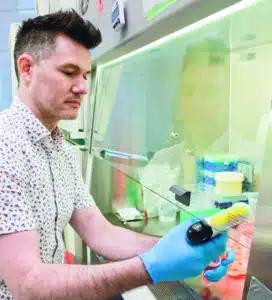MS is prevalent enough in Australia that Shane Liddelow, PhD, first heard about the disease in grade school. In fact, he remembers participating in a readathon to raise money for MS as a child. But as an adult studying at the University of Melbourne, Liddelow wasn’t focused on MS. Instead, he earned his bachelor’s degree in biomedical science in 2007, followed by a doctorate in pharmacology.It wasn’t until he began postdoctoral training at Stanford University’s Department of Neurobiology in 2012 that Liddelow gravitated toward MS research. His mentor, Ben Barres, was a leader in research of astrocytes, which are a type of cell found in the brain. Barres, Liddelow and other team members discovered that astrocytes can secrete a toxic fatty (lipid) molecule that can kill oligodendrocytes, which are the cells that make the myelin that protects nerve fibers. Fewer oligodendrocytes means less myelin, which can lead to damaged nerve fibers and MS symptoms. So, discovering this toxic lipid molecule is a big deal.“As soon as you have a molecule, you can work out how it’s produced and delivered, and how to protect the oligodendrocytes from taking it up,” Liddelow says. This gives pharmacologists a target for a drug to block these lipid molecules and potentially stop myelin erosion and the resulting MS symptoms.“This drug could be so novel that it would be first in its class,” Liddelow says. Much more research is needed, but “we think this finding is very compelling,” he says. “We have cautious optimism.”Liddlelow and his team at the New York University Grossman School of Medicine’s Neuroscience Institute are currently conducting more research into the lipid molecule’s effects on not only MS, but also other neurological diseases like Parkinson’s.Liddlelow’s five-year MS Society research fellowship is helping fund his work on a study in which mice with an MS-like disease have been genetically engineered to either not produce the lipid molecule or turn off production of the molecule. Liddlelow’s team is testing whether the mice’s motor skills improve when they don’t produce the molecule, and how blocking the molecule affects the health of oligodendrocytes. Then, they’re comparing these molecular changes in mice with samples from people with MS.Liddlelow believes if a drug can be developed to target the molecule’s effects, it could be part of a multipronged approach to preventing and treating MS. “I don’t think for complex neurogenetic diseases there will be a single treatment or a cure, so to speak,” he says. But his research could very well be one of the keys to a cure.Liddlelow came to the United States to conduct this type of cutting-edge research. “There are a lot of fantastic opportunities for young people to do science here, whether you’re a citizen or not,” he says.“And all of this pioneering work I’ve been able to be involved in is seeded by the MS Society. That’s really very impressive. It’s important that there are these foundations that are able to fund research that takes more of a risk, like our research.”








